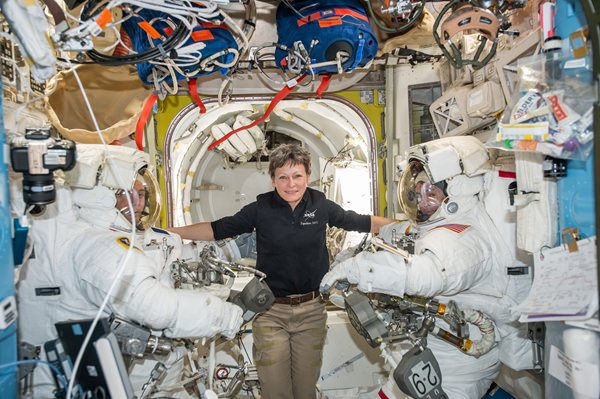Peggy Whitson is adding more time to an already record-breaking mission after signing an agreement to stay on the International Space Station for an additional three months.
Instead of returning to Earth in June 2017 with the Soyuz MS-03 capsule she launched in along side Russian cosmonaut Oleg Novitsky and European Space Agency astronaut Thomas Pesquet, 57-year-old Whitson will remain aboard the ISS and fly home in September 2017 with the crew of Soyuz MS-04, which will have a vacant seat.
“This is great news,” Whitson said. “I love being up here. Living and working aboard the space station is where I feel like I make the greatest contribution, so I am constantly trying to squeeze every drop out of my time here. Having three more months to squeeze is just what I would wish for.”
Soyuz MS-04, which will launch Russia’s Fyodor Yurchikhin and NASA’s Jack Fischer, will have a vacant seat because of Russia’s decision to temporarily reduce the size of its ISS crews from three to two. This is in a bid to save money on Progress resupply launches until the long-delayed Nauka science module is launched. That is expected sometime in 2018 at the earliest.
According to NASA, Whitson’s extra time in orbit will ensure a full complement of six astronauts on board the station and increase the amount of time available for astronauts to conduct experiments.
“Peggy’s skill and experience makes her an incredible asset aboard the space station,” said Kirk Shireman, NASA’s International Space Station Program Manager. “By extending the stay of one of NASA’s most veteran astronauts, our research, our technology development, our commercial and our international partner communities will all benefit.”
Whitson is on her third long-duration stay aboard the ISS. She flew as part of Expedition 5 and Expedition 16 in 2002 and 2007 respectively. Those two missions gave her 377 days of spaceflight experience.
She has been in space since Nov. 17, 2016, for Expedition 50. On April 24, 2017, she will break retired astronaut Jeff William’s record of 534 cumulative days in space – the most for any American.
With the three-month extension to September 2017, she will accumulate at least 663 days of total spaceflight time. This will put her in a solid seventh place behind retired cosmonaut Valeri Polyakov, who spent some 679 days aboard the Mir space station over two long-duration missions in 1988 and 1994.
The person with the most cumulative days in space is Gennady Padalka at 879 days over five missions. He is scheduled to launch to the space station again in September 2018 aboard Soyuz MS-10. At the end of that six-month flight, he will become the first person to cross 1000 days in orbit.
Whitson’s extended flight will mean her current stay should last at least 287 days. This will make it the longest single spaceflight by a woman, surpassing the 200 days set by ESA’s Samantha Cristoforetti.
Just recently, Whitson broke the record for the most spacewalks by a woman, beating Sunita Williams’ seven EVA’s by one for a total of 53 hours, 22 minutes outside the station.
That record is set to grow by about six more hours in late April when Whitson leads EVA-42. If that spacewalk goes as planned, it should put her in third place for the most spacewalking time, behind retired astronaut Michael Lopez-Alegria’s 67 hours, 40 minutes.
The person with the most spacewalking time is retired cosmonaut Anatoly Solovyev at 82 hours, 22 minutes of experience.
On April 10, the crew of Soyuz MS-02 will leave the outpost. That includes Russian cosmonauts Sergey Ryzhikov and Andrei Borisenko, and NASA astronaut Shane Kimbrough, who is the commander of Expedition 50.
Kimbrough will hand over command of the ISS to Whitson the day before he leaves, making her the first woman to command the orbiting lab twice. Expedition 50 will switch over to Expedition 51 as soon as Soyuz MS-02 undocks from the Poisk module.















